If you buy through our links, we may earn an affiliate commission. This supports our mission to get more people active and outside.Learn about Outside Online's affiliate link policy
The Best Trekking Poles for Hiking and Backpacking (2025)
Some still debate the merits of using trekking poles, but most hikers won’t leave home without them. Poles can help you power up steep climbs, support your weight on downhills, and provide extra points of contact for balance on loose or uneven terrain. The best trekking poles are comfortable in hand, stiff under load, easy to stow away in your pack, and can help you tackle challenging terrain and hike pain-free.
At A Glance
- Best Overall: MSR Dynalock Ascent Carbon ($190)
- Most Durable: Diorite Gear Telescopic Carbon Fiber Trekking Poles ($190)
- Best Ultralight: Durston Gear Iceline ($199)
- Best Aluminum: Black Diamond Trail ($120)
- Best Budget: Retrospec Solstice ($25)
- Best Fixed-Length: REI Co-op Swiftland TT Carbon Folding ($179)
- Best Ergonomics: LEKI Legacy Lite ($110)
- Most Affordable Carbon: Cascade Mountain Tech Quick LockCarbon ($65)
- Best Folding: LEKI SkyTera FX Carbon SL ($220)
- Best for Multi-Use: Argali Carbon X ($174)
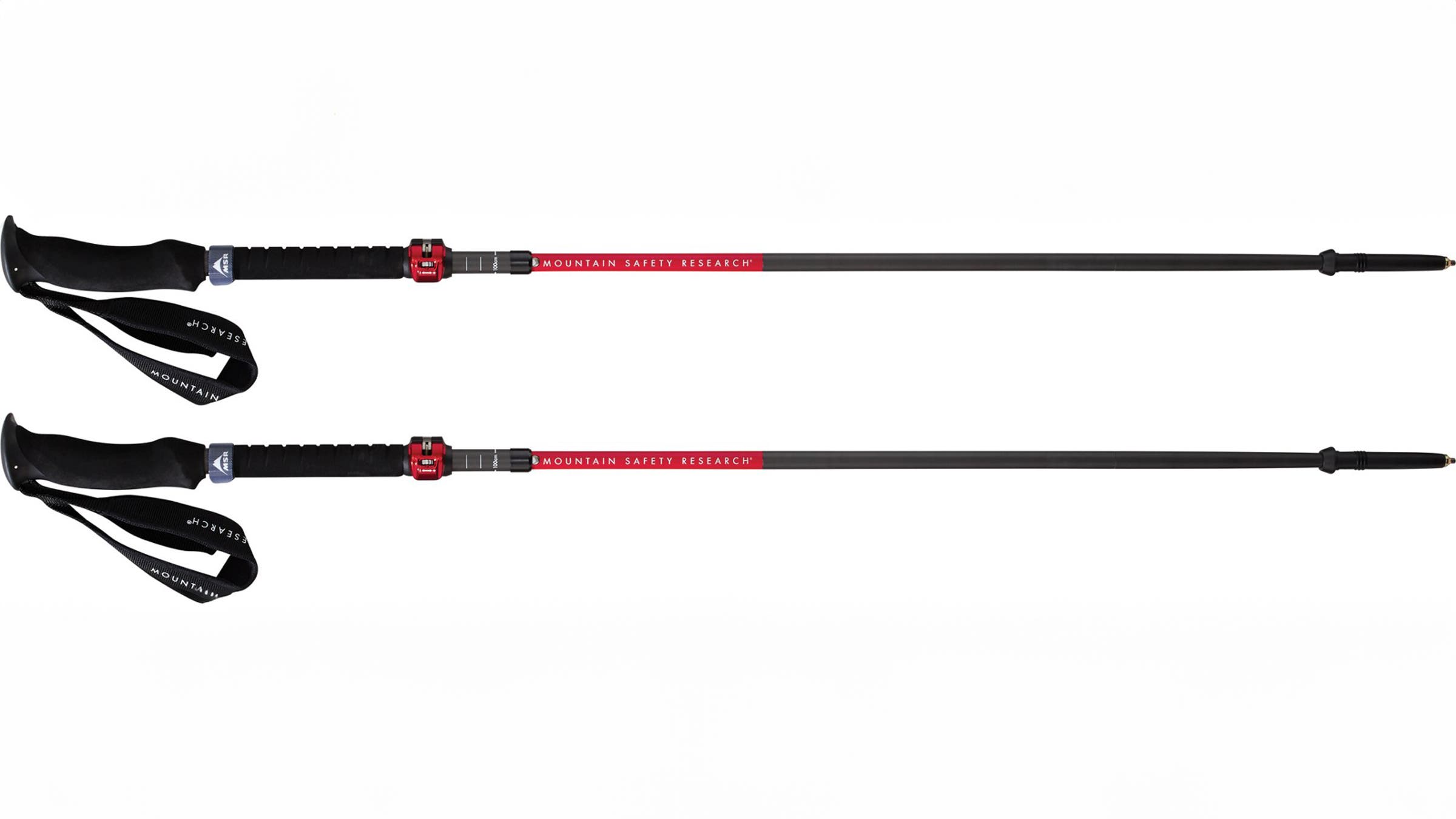
Best Overall
MSR Dynalock Ascent Carbon
Size: Small (100-120 cm), Large (120-140 cm)
Weight: 8 oz (per pole)
Pros and Cons
+ Light
+ Stable
+ Packs down small
– Expensive
We named the MSR Dynalock Ascent Carbon our top trekking pole for its combination of low weight, durability, and packability. Choosing a folding pole like the Ascent Carbon as our “best overall” is a bit of a departure. While folding poles like these pack down small and set up quickly, they also tend to lack the stiffness and long-term durability of a classic telescoping design—not ideal for backpackers and hikers. Some feel flimsy and bendy, others are prone to snapping, and a few even fail at the plastic connectors between sections.
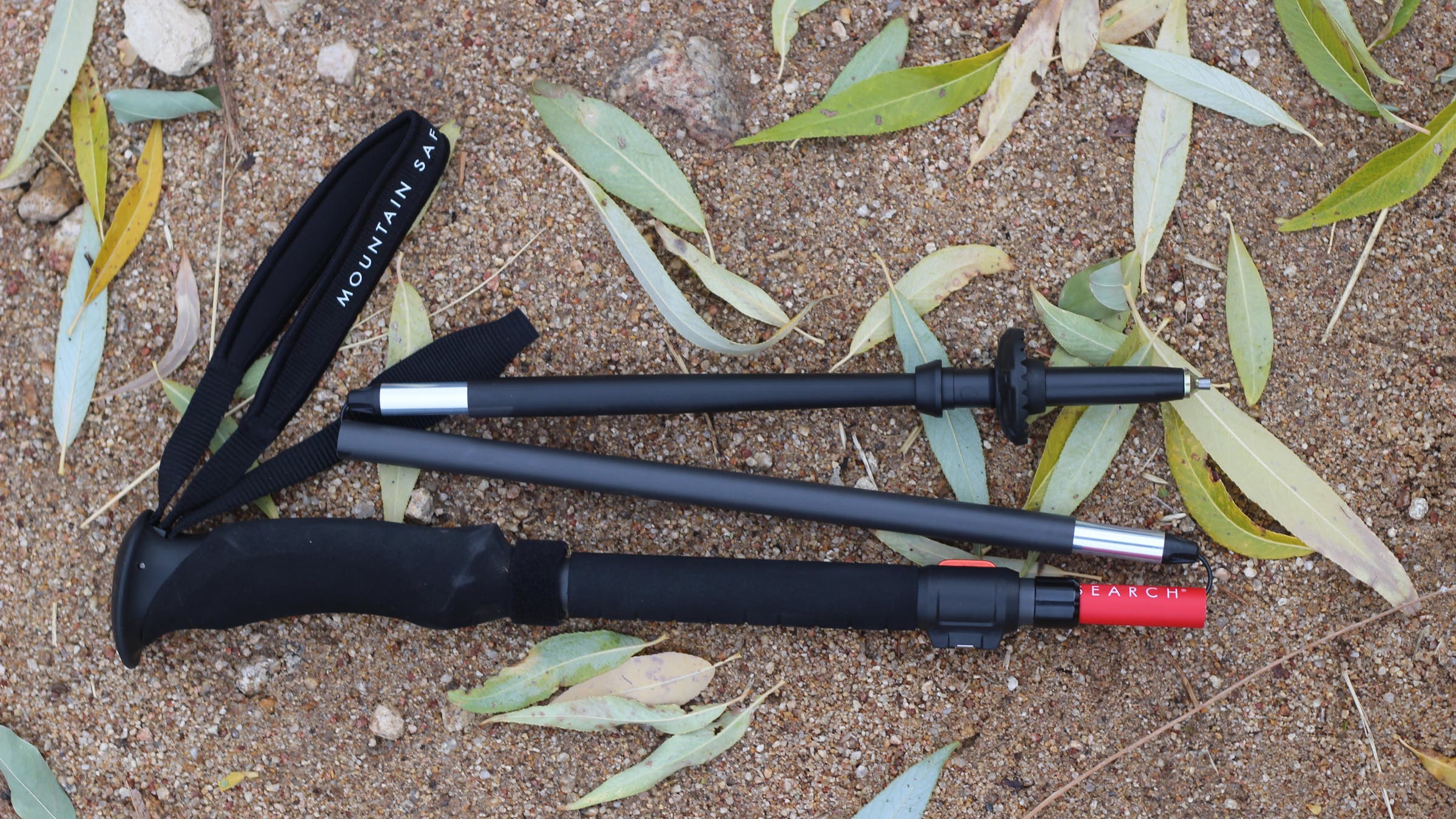
But the Ascent Carbon is a combination pole, with three folding sections and one quick-lock to adjust the length. It felt rock-solid through a year of testing that included hikes in Idaho’s Hells Canyon Wilderness and ski tours in Alaska’s Chugach Mountains, and we never felt like we hit the pole’s limit in terms of stability.
At eight ounces per pole, it’s not the lightest on the market. But it offers the support backpackers need during steep descents with heavy packs and durability that long-distance hikers can count on. Plus, it packs down as small as any folding pole set (14.25 inches for small, 17.5 inches for large) and sets up in a few seconds.
The Ascent Carbon earned top marks for comfort and versatility as well. The foam grips weren’t our favorite in test, but proved comfortable during 10-12 hour days on trail, and their long length allowed for extra hand positions on climbs. Padded nylon wrist straps scored at the very top with our testers. Testers also appreciated the burly quick-locks, which could be tightened without a tool and never slipped during testing.
The biggest knock against the Ascent Carbon is the adjustment length, which is only 20 cm (7.9 in). That’s good for a folding pole, and served most of our average-height testers. But one 5’3” tester, who used the “small” version of the pole comfortably on the trail, found its maximum extension too short for her trekking pole shelter pitch.

Most Durable
Diorite Gear Telescopic Carbon Fiber Trekking Poles
Size: One size (71-158 cm length)
Weight: 7.4 oz (per pole)
Pros and Cons
+ Sturdy
+ Impessive maximum length
+ Easy to repair
– Overkill for traditional tent users
The Diorite Telescopic Carbon Fiber is a rare no-compromises trekking pole: it’s the burliest all-carbon construction we’ve ever tested, with a formidable telescoping length that’s a godsend for tarp-oriented thru-hikers. The first thing testers noted was that even though the Diorite looks and feels like an overbuilt aluminum pole, it tips the scales below 8 ounces—a weight limit normally reserved for folding fast-packing poles.
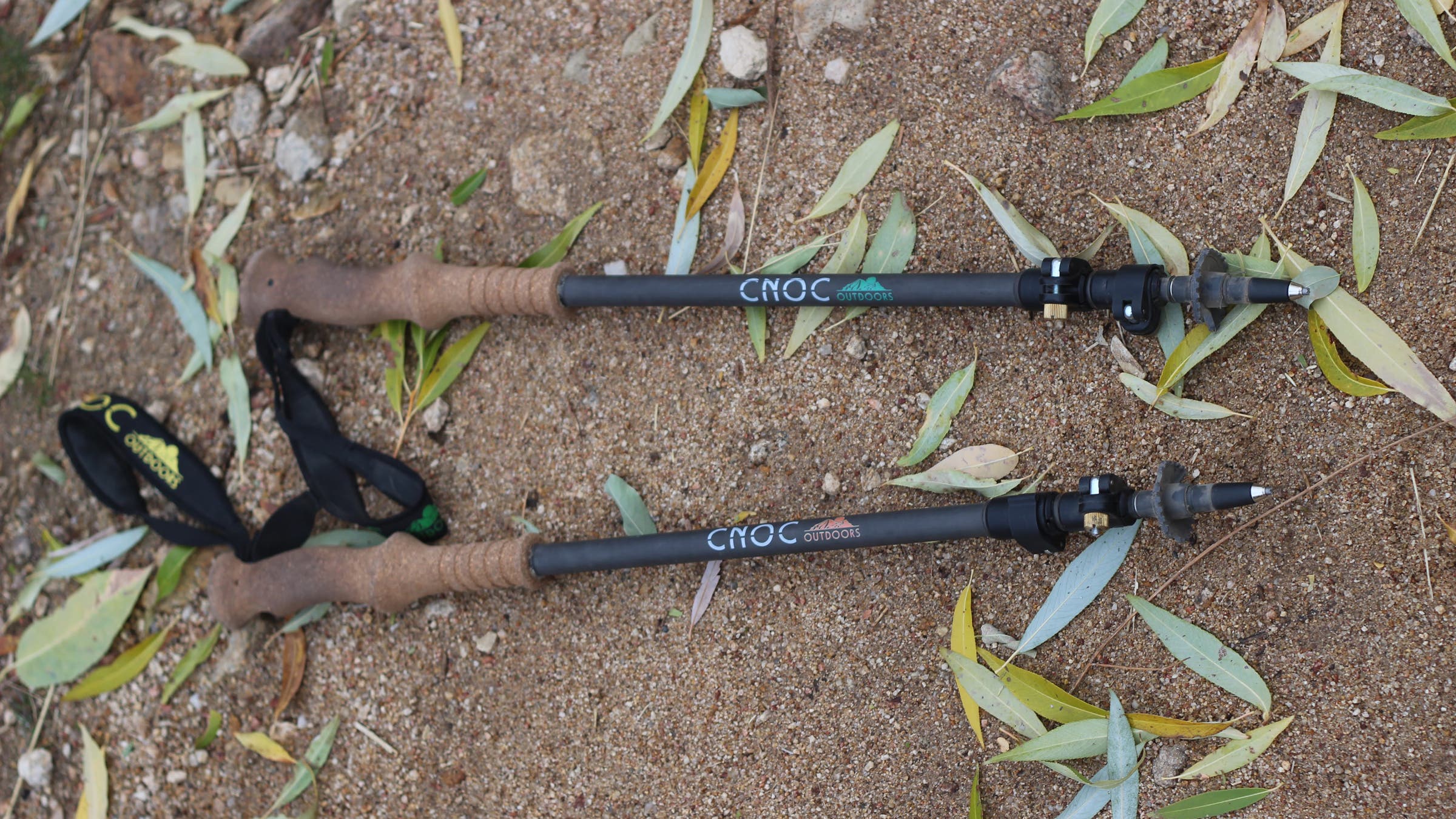
Most ultralight carbon poles in that weight class require babying. In contrast, the Diorite inspired confidence even when several testers slid down steep, sandy descents in Idaho’s Salmon River Mountains. The extra-long EVA foam (also available in cork) grips were comfortable in hand and made it easy to choke down on steep climbs without stopping to readjust the length of the poles. The beefy locking mechanisms are replaceable, along with the individual pole sections and pole tips. As a bonus for in-field repairs, the Diorite uses a self-threading aluminum adapter that will accept replacement tips from other brands, even if they’re unthreaded.
Best of all, the Diorite poles come with an unusual perk: they extend all the way to 158 centimeters. While that extra length isn’t necessary for on-trail use (even our 6’5” tester rarely exceeds 135 centimeters), it does provide a few advantages. For one, all that extra carbon reinforces the poles, making them extra stiff and sturdy. For another, the generous telescoping range means that they can be used to set up nearly any tarp or tent that requires trekking poles. “It’s nice to know that no matter what shelter I bring, these poles will work—even if I opt for my pyramid tarp with a high center height,” said New Hampshire-based tester Dan Huntington. Between its weight, comfort, and durability, the Diorite is one of the few trekking pole quiver-killers on the market.

Best Ultralight
Durston Iceline
Size: One size (95-127 cm)
Weight: 4.7 oz without straps (per pole)
Pros and Cons
+ Incredibly stiff for the weight
+ Unique mix of folding and telescoping tech
– Fairly small adjustment range
– Spotty availability
The Iceline continues Durston Gear’s reputation for rethinking and improving on stale backpacking designs: It is the stiffest pole we tested this year, even though it’s also the lightest of the bunch.
That’s mostly due to the simplified folding-pole style design. The lower sections lock in place using an all-aluminum “quick connect” attachment. Since the lower section doesn’t have to slide into the middle section when stored, it can be larger, a full 16 millimeters in diameter, a serious strength upgrade from the 11-12 millimeters lowers on telescoping models. The Iceline’s attachment system is also more secure than other folding models. For one thing, there’s fewer moving parts: the Iceline has just one folding connection point, where most folding poles have two. Plus, the aluminum connector introduces less wobble into the system than the plastic hardware used in other folding poles.
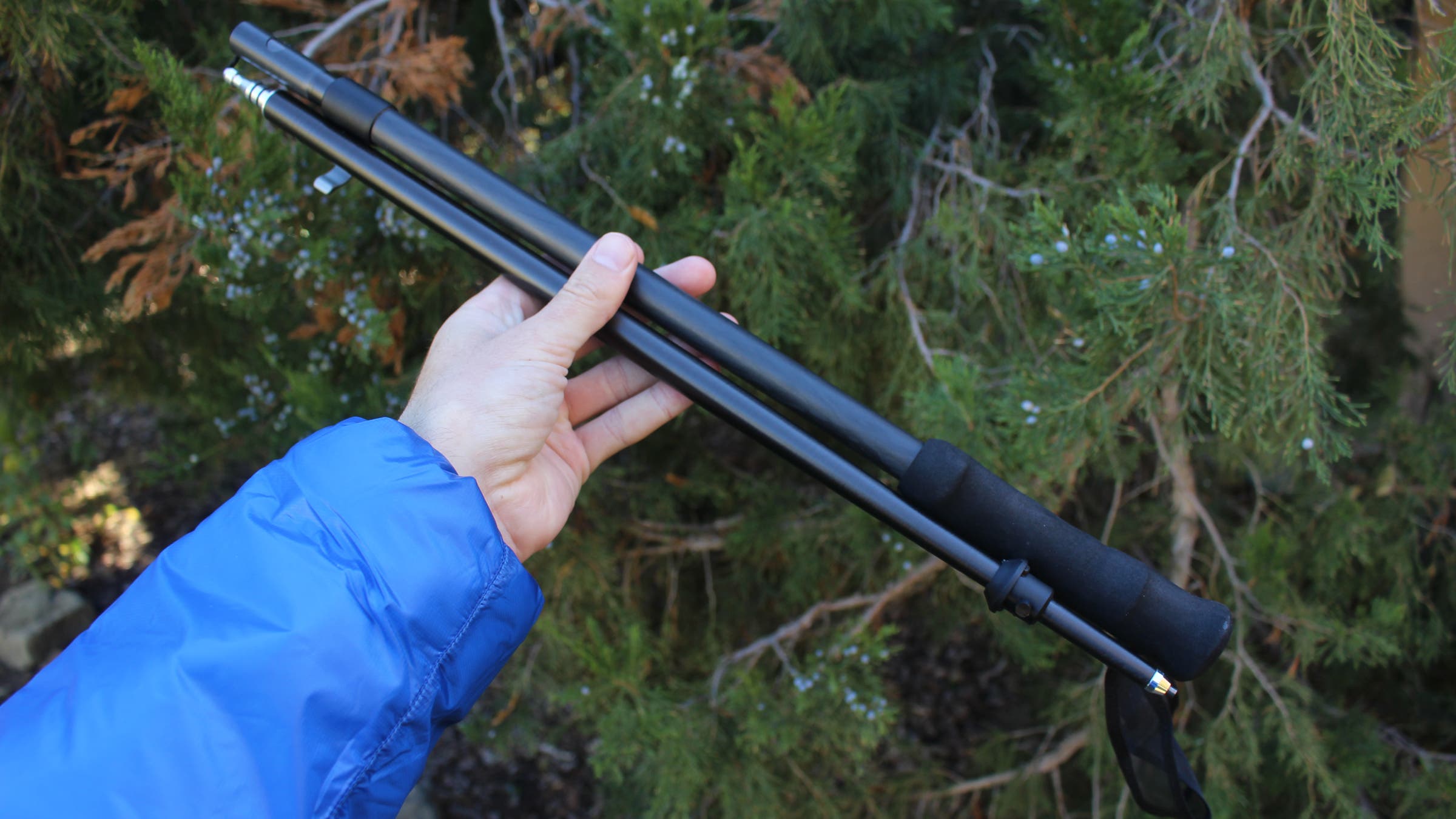
There are some downsides to the Iceline’s novel design. With a max length of only 127 centimeters, it’s too short for very tall hikers and some trekking pole tent designs. And at 19.5 inches when packed, it’s long compared to other folders and slow to deploy and collapse: The pole sections must be lined up and pushed into place by hand, and the quick-connect mechanism takes a bit of elbow grease. Also, to save weight, the Icelines don’t have gaskets to keep the pole sections from fully sliding apart when the locking mechanism isn’t engaged—something that might throw off new users.
Our testers universally preferred the poles with optional straps, which raises the weight per pole to 5.3 ounces. True to form, the supplied straps are made of a thin and lightweight mesh. If you prefer straps with padding or a supple feel, these won’t be your favorite, but we did find them incredibly breathable in hot weather.
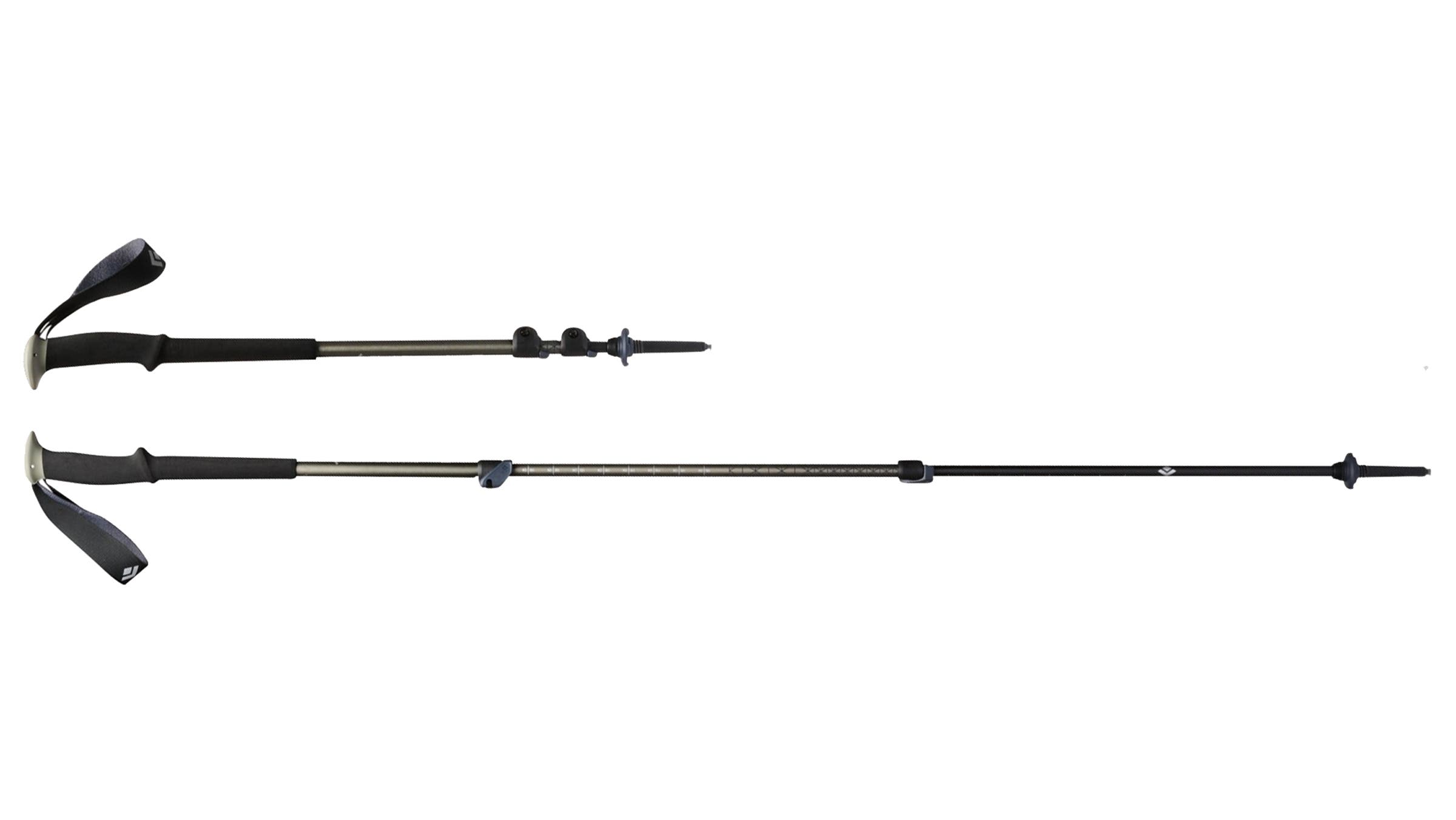
Best Aluminum
Black Diamond Trail
Size: One size (100-140 cm length)
Weight: 8.5 oz (per pole)
Pros and Cons
+ Sturdy
+ Dependable
+ Relatively lightweight
– A bit spendy for aluminum
Trekking poles are one of those items you shouldn’t need to replace often—if ever. For that kind of worry-free investment, we’d choose Black Diamond’s Trail trekking poles, a tried-and-true classic that Backpacker staffers and testers have used for years without bending or lock failure.
One tester used the Trail on four separate mountaineering trips in the Cascades without so much as a slip. At just 8.5 oz, they’re about as light as any aluminum pole on the market. But they’re also reliably stiff, without any of the concerning flex that can plague cheaper poles. That’s thanks to BD’s material of choice: 7075 aluminum, which is stiffer and lighter than the lower-grade aluminum used in budget options. Extended EVA foam grips help keep the weight low (cork is a comfy, but heavy, upgrade) and offer extra length for hikers who choke up on their poles during climbs or prefer having multiple hand positions.
We also appreciated the Trail’s tech tips, which allow you to switch out the carbide tips with screw-on rubber ones. It’s a more secure and elegant solution than the easily-lost press-on rubber tips that many poles use.
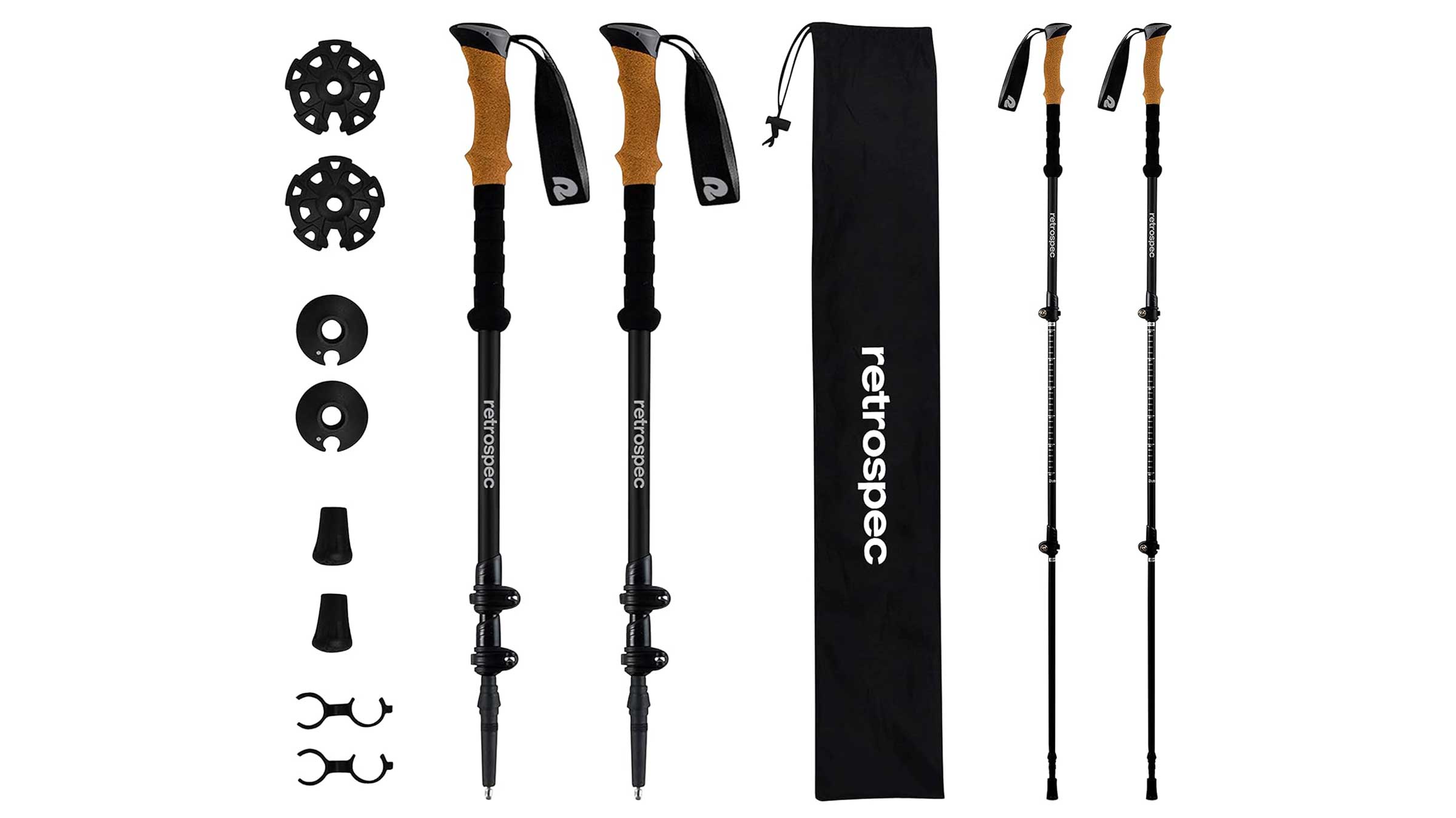
Best Budget
Retrospec Solstice
Size: One size (110-135 cm length)
Weight: 11.3 oz (per pole)
Pros and Cons
+ Cheap
+ Durable
– Heavy
If you’re on the fence about the value of trekking poles, cost is likely the main consideration. Our new favorite pair of dirt-cheap poles is the Retrospec Solstice. Like many other budget poles, the tips are carbide, the shafts are sturdy 6061 aluminum, and they employ a common three-piece telescoping design.
The real difference is the price. Other budget options typically run about $40, and, even though the Solstice rings up at just $25, they perform as well if not better than anything we’ve tried at that higher price point. Testers appreciated the solid feel—there was little bend in the shafts—as well as the foam and cork handle options. While the locking mechanisms didn’t feel particularly burly, we never had any issues with the poles slipping or the locks breaking. For the price, it’s hard to ask for more. As one long-time trekking pole user said, “My favorite poles are usually the budget ones. I never worry about snapping a pole because replacing them won’t break the bank.”
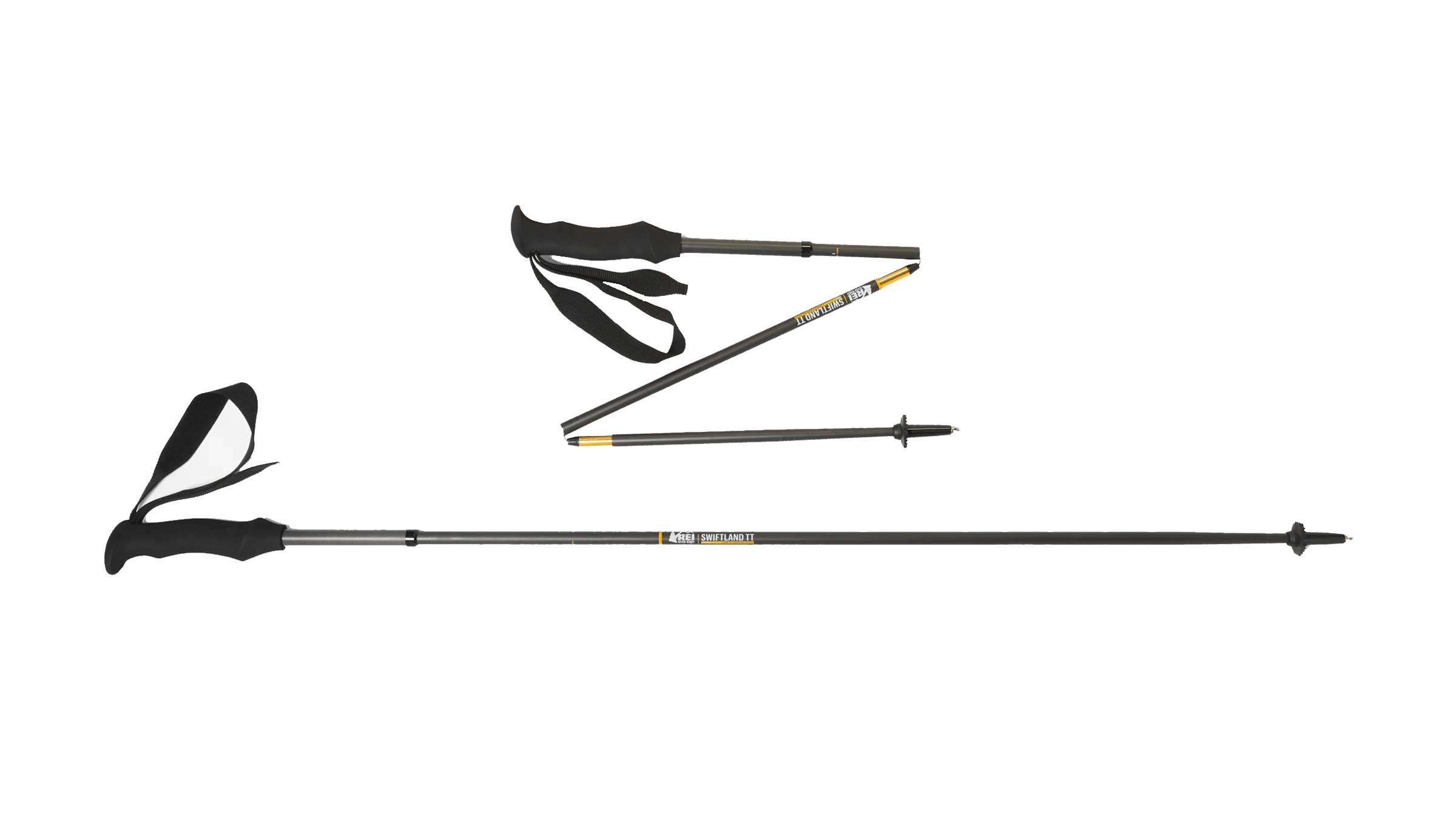
Best Fixed-Length
REI Co-op Swiftland TT Carbon Folding
Size: 105, 115, or 125 cm (non-adjustable)
Weight: 5.6 oz (115 cm, per pole)
Pros and Cons
+ Easy and fast deployment
– Short for some shelter designs
For trekking poles, simplicity often equates to durability. Case in point: the non-adjustable REI Co-op Swiftland TT. These poles do break down into shorter segments, via a folding mechanism, but they have only one usable length. That eliminates the need for locking mechanisms, a common point of failure. If you’re confident in the length of pole you need, they’re a great option.
Testers loved the quick and easy set-up, as well as the ultra-small packed size (about 14 inches), which make them especially handy for anyone who finds themselves putting their poles away and pulling them out again as trail conditions change. On a 35-mile trek on the Art Loeb Trail in North Carolina that featured more than 9,000 feet of climbing and descending, one first-time pole user was impressed by the Swiftland TT’s specs: They have the stiffness of a telescoping pole in a lighter and sleeker package.
The foam grips are extended length, which we find particularly helpful on fixed length poles, since choking up on the grips is the only way to make the poles shorter on steep climbs. The biggest downside? Most fixed length poles won’t work as trekking pole shelters, which require a specific pole length that is usually longer than the average person’s preferred pole length for hiking.
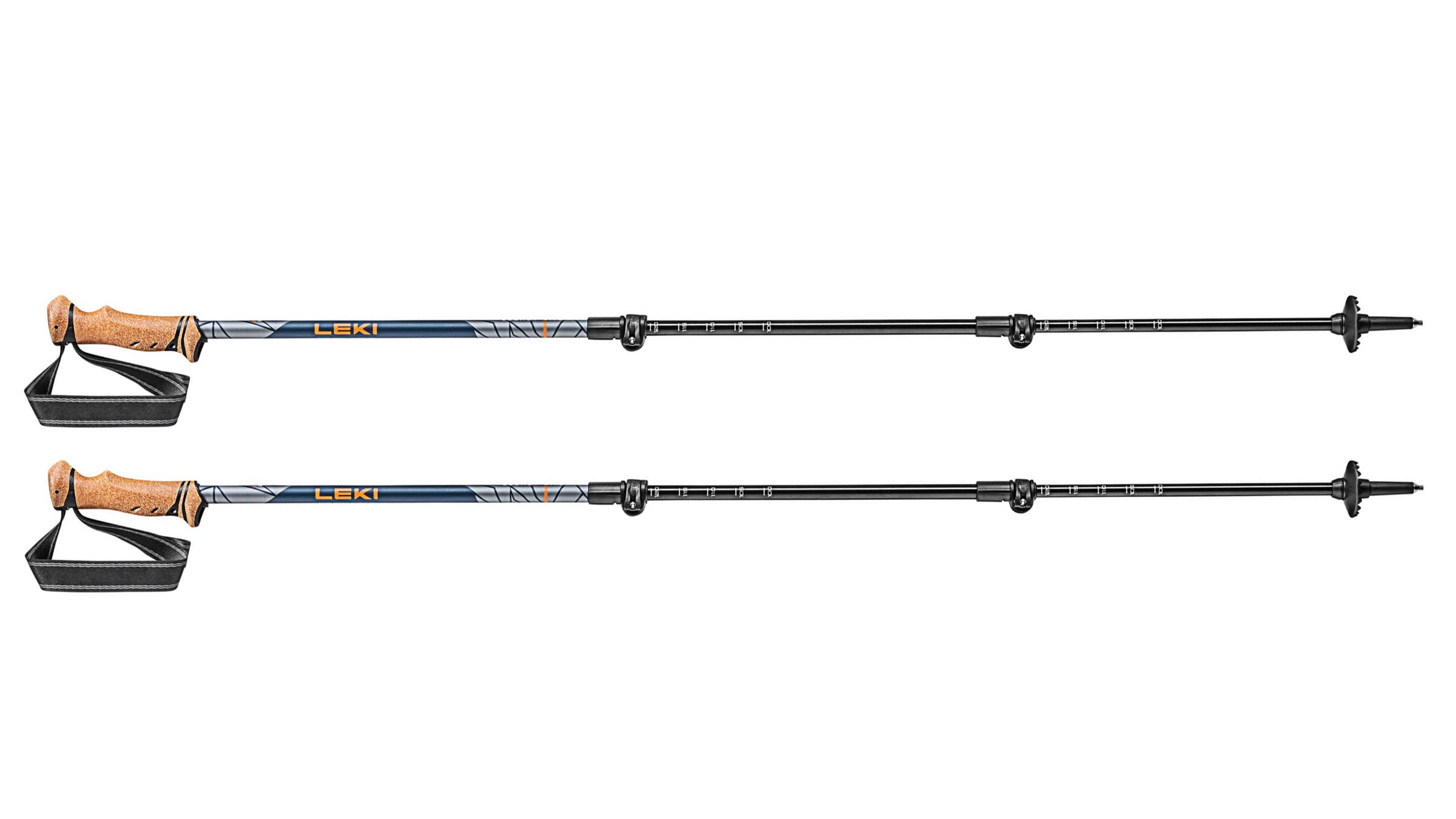
Best Ergonomics
Leki Legacy Lite
Size: One size (100-135 cm)
Weight: 9 oz (per pole)
Pros and Cons
+ Comfortable, durable cork grips
+ Dependable support
– Not the lightest
LEKI’s Legacy Lite model is proof that you can get best-in-class ergonomics without breaking the bank. Over the years, we’ve tested dozens of models from many brands with grips of all shapes and sizes, and the Legacy Lite ranks near the top, alongside poles that cost more than twice as much.
That’s down to the Legacy Lite’s ergonomic shape and materials. The grip is corrected for some forward lean that feels just right while in motion. And it has just enough shape to it, with knobs on the top and bottom of the grip and one protrusion under the index finger, to provide feedback without locking users into just one grip position. The grip material, a blend of soft cork and durability-boosting rubber, felt great underhand, even after absorbing a few layers of sunscreen. Finally, the soft and pliable nylon webbing strap never chafed or rubbed, even on sweaty hands. “If I hold out my hand in a natural position, it’s like these poles just slot into place perfectly when I close my grip,” one tester reported.

Outside of ergonomics, there’s not much that sets the Legacy Lite apart. But when the brand in question is LEKI (the maker of the Makalu, the first trekking pole ever) that’s not a bad thing. There’s the standard, three-piece telescoping system, which locks into place with the same dependable Speed Lock Plus locking mechanisms found on most LEKI poles. At 9 ounces a piece, these aren’t the lightest poles out there, but they felt reassuringly stable thanks to the 12 mm bottom section (some poles cut weight with skinnier lowers).
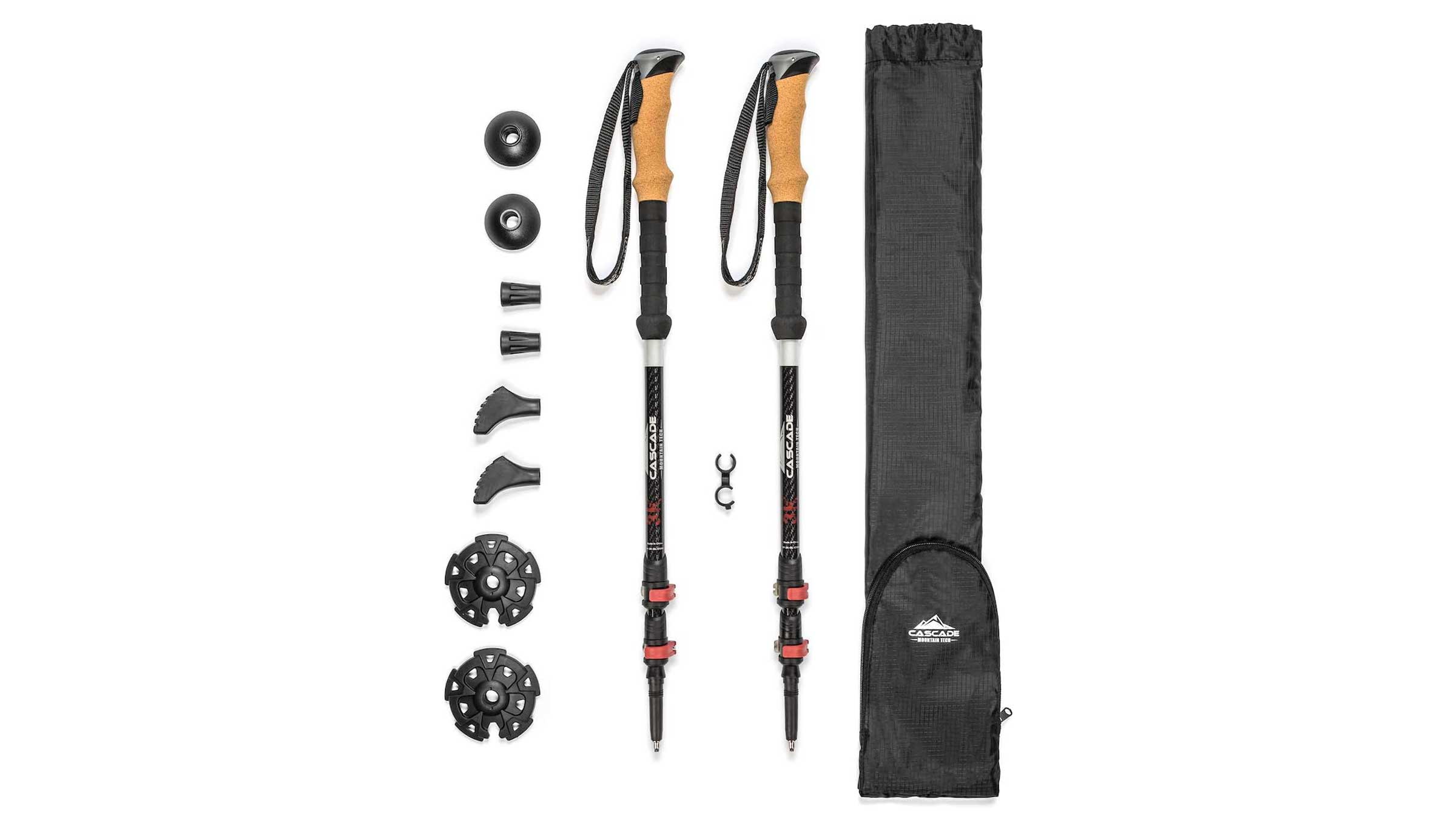
Most Affordable Carbon
Cascade Mountain Tech Carbon Fiber Quick Lock
Size: One size (66-137 cm length)
Weight: 8 oz (per pole)
Pros and Cons
+ Durable
+ Lightweight
+ Affordable
– Hardware feels cheap
Carbon fiber trekking poles are coveted for their lightness and stiffness, but they often come at a premium price. Our favorite exception is the Cascade Mountain Tech Carbon poles, which have a price point below many brands’ aluminum options. They’re light enough, offer a good range of adjustability, and are plenty durable: After four years of testing, we still haven’t managed to break a pole.
As for design, Cascade Mountain Tech employs a standard three-piece, telescoping system, and the poles come with a selection of rubber tips and baskets that you can change out depending on trail conditions. Cork grips are a soft-but-durable upgrade that’s uncommon at this price point.
Our biggest complaint? The plastic quick locks feel cheap and have too much play unless you tighten them a bit more than feels necessary (they stay put once they’re locked, though). It’s also worth noting that while carbon is often touted as a weight-saving material, at eight ounces, these poles aren’t much lighter than an aluminum pole. For $65, though, the combination of strength, weight, and features that these poles offer is hard to beat.
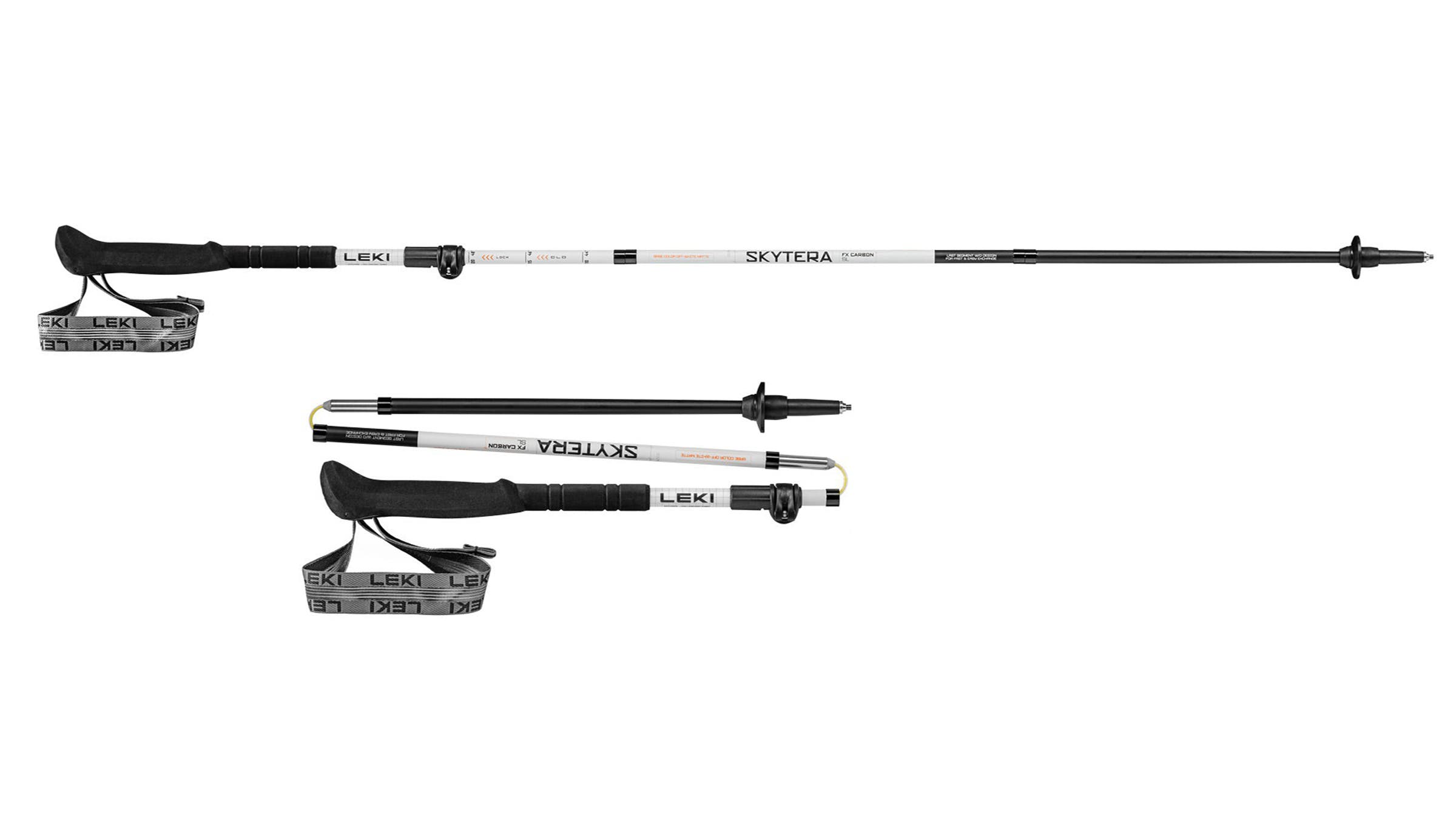
Best Folding
Leki Skytera FX Carbon SL
Size: One size (110-130 cm)
Weight: 6.3 oz (per pole)
Pros and Cons
+ Incredibly light
+ Good grip ergonomics
– Some slippage in the strap adjustment
– Fairly pricey
In 2025, adjustable folding poles are nothing new. There are plenty of options, with most falling into two distinct camps: Sturdy-but-weighty hiking poles or svelte ultralight models favored by trail runners. LEKI’s newest model, the Skytera bridges both styles: while it weighs just 6.3 ounces per pole, it felt up to any challenge we sent its way during testing, from boulder-strewn climbs in the White Mountains to scree-filled descents in the Wasatch. All told, the Skytera isn’t just an expendable option for racers, but a durable choice that can withstand daily hiking. “I’d trust these poles to complete my triple crown,” said our New Hampshire-based tester who’s completed both the AT and PCT.
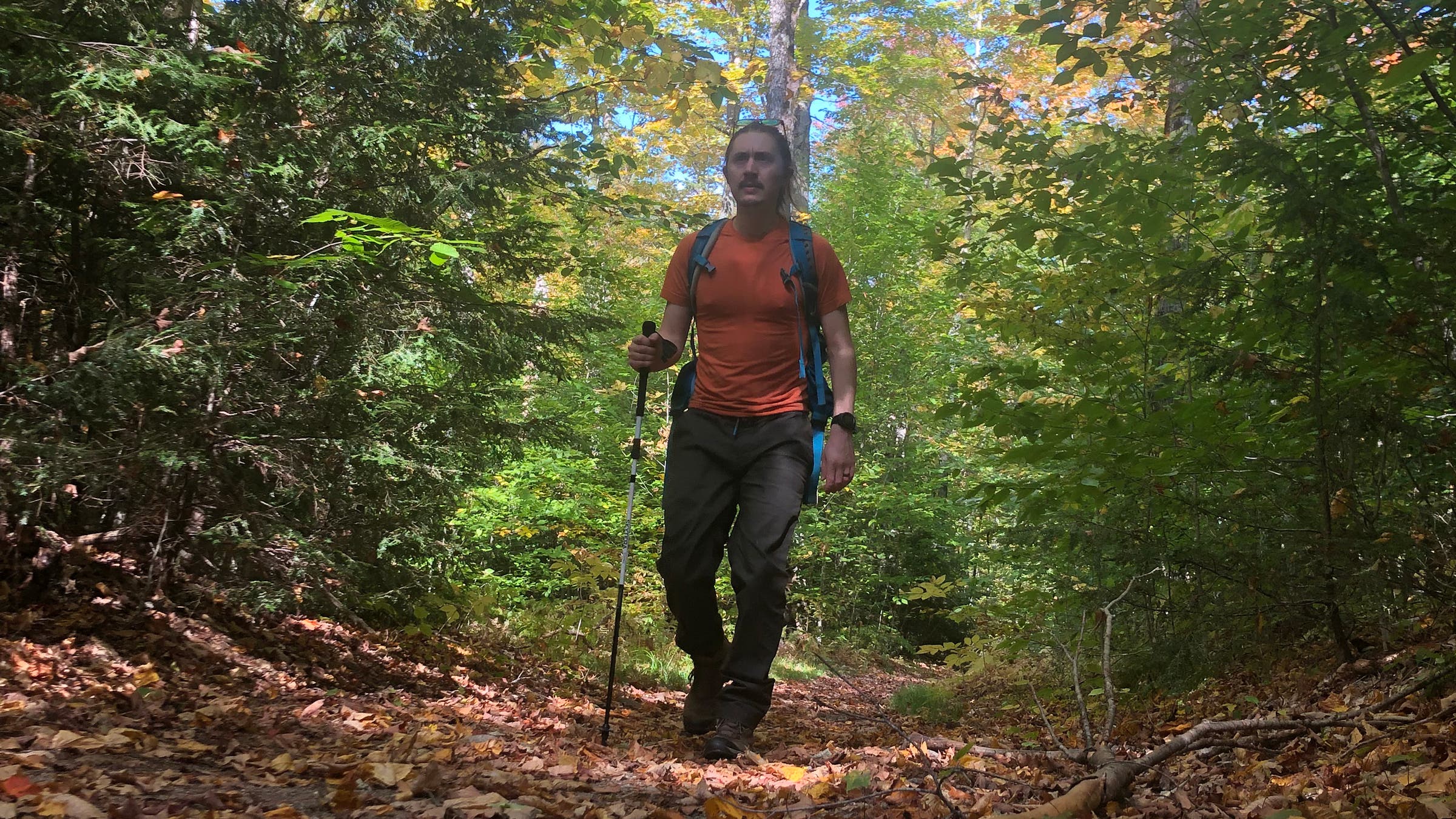
Comfort was up to LEKI’s high benchmarks. There are spongy foam grips with a similar ergonomic shape to the one we gushed over in the LEKI Legacy Lite, that have the added benefit of extra-long length, which testers appreciated during sustained, steep climbs. One ding: while the straps were easy to adjust, testers also found they could work themselves loose when enough force was applied during climbs.
LEKI’s four-piece FX folding system is also best in class. Setup is a breeze (“It literally takes just a few seconds,” one tester said) and the adjustment range of 20 centimeters is on par or better than its competitors. Best of all, the FX system is repairable, not just under warranty but also at home with a few replacement parts.
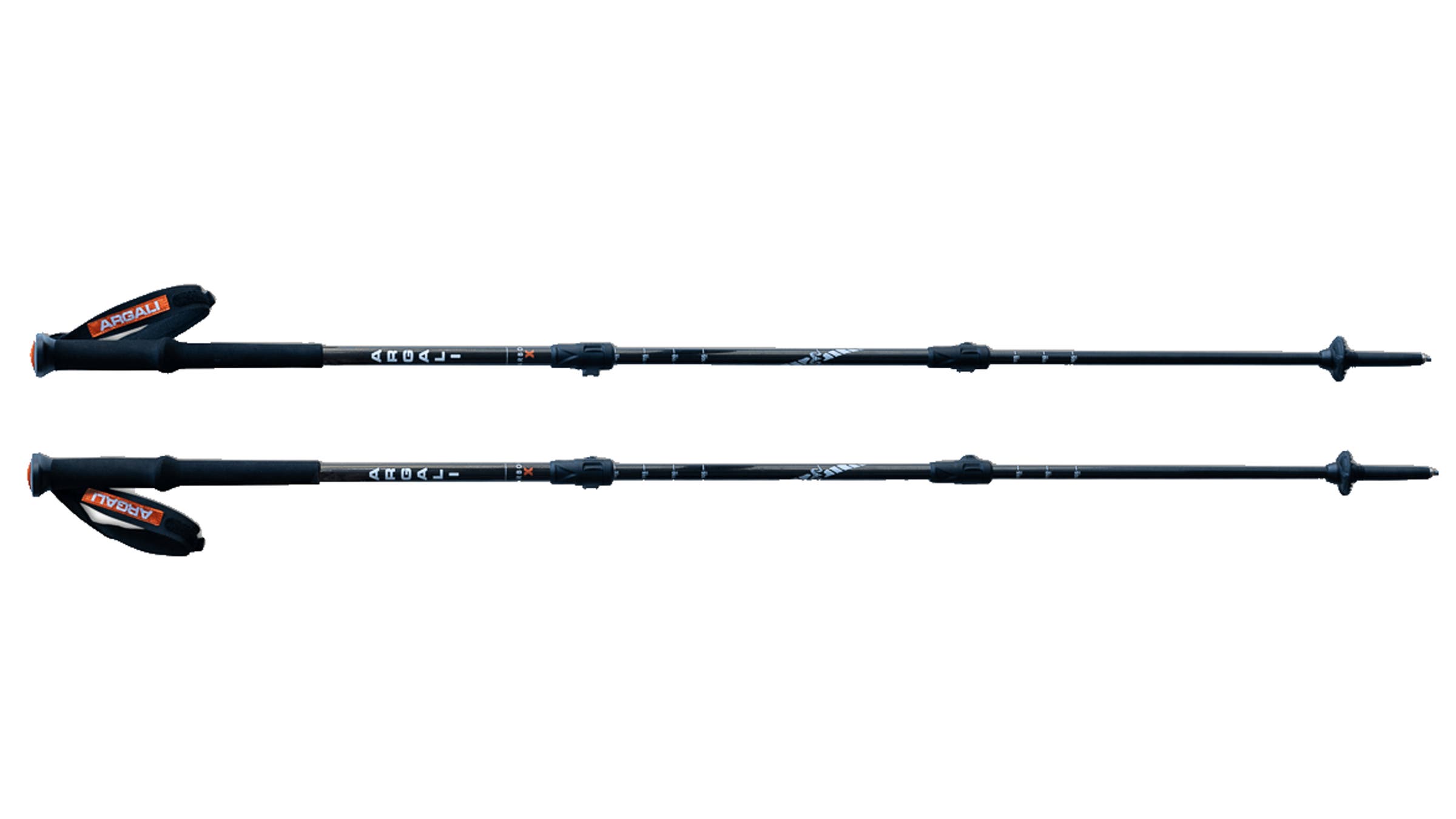
Best for Multi-Use
Argali Carbon X
Size: One size (140 cm)
Weight: 7.5 oz (per pole)
Pros and Cons
+ Useful accessory attachment system
+ Great stability for carbon
– Small grips
Have you ever looked at your trekking pole and thought, “This would make a great monopod?” If so, chances are you’re a photographer, birder, or hunter, and the Argali Carbon X is the pole for you. Hidden beneath a rubber top cap on the pole’s grip is a threaded insert that pairs with two different adapters. The X3 adapter threads into tripod mounts on cameras, binoculars, or spotting scopes, while the QuickShot adapter serves as a gun rest.
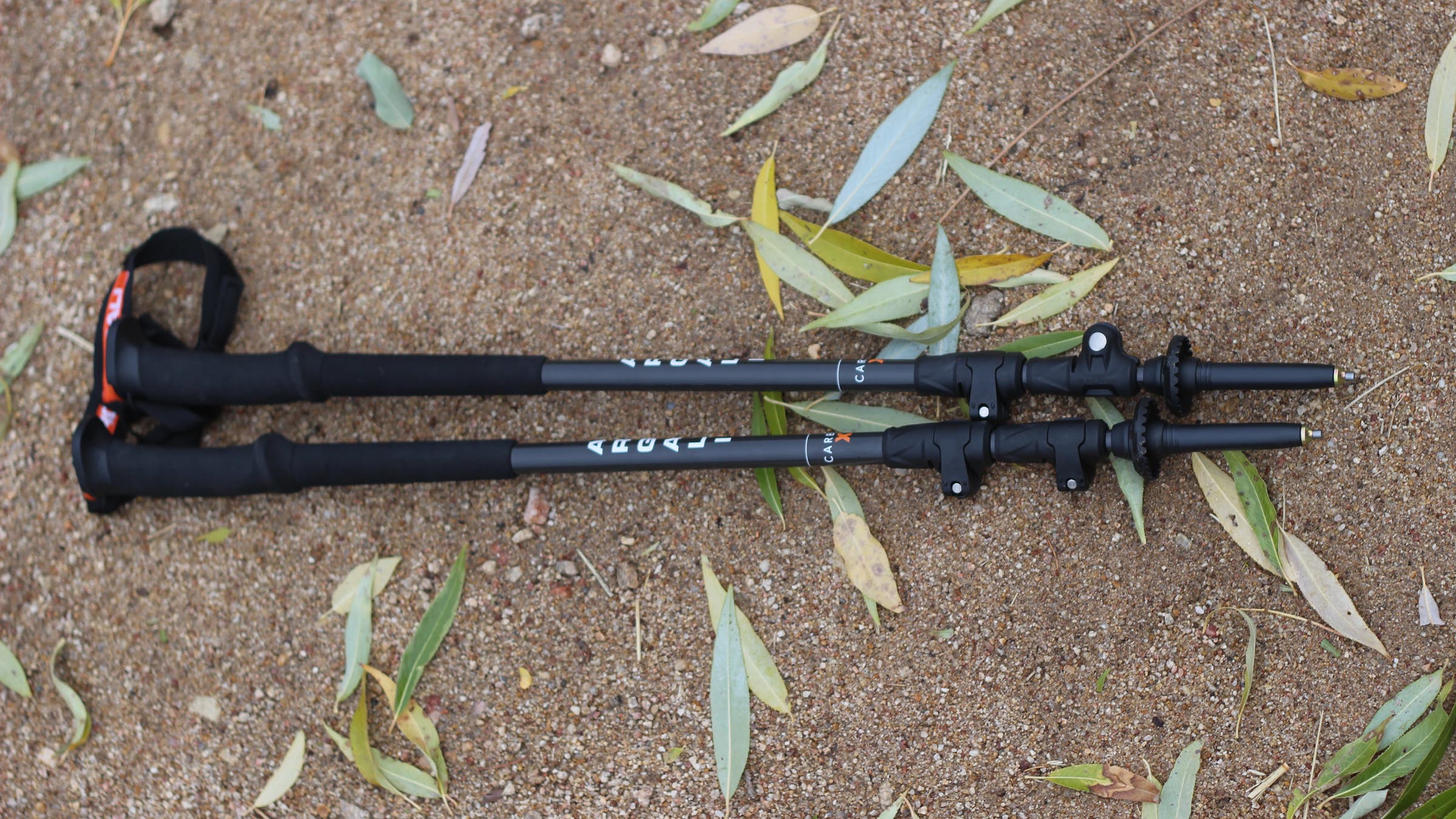
Our testers used the X3 to attach their DSLR cameras to great effect. The adapter, machined from aluminum, has high-quality threads that we trusted to attach expensive equipment, and the poles proved perfectly sturdy, even with a telephoto lens attached up top.
A second use for the X3 adapter? To attach both trekking poles together to create one extra-long pole to set up a tarp or pyramid tent. We found this works, but it is noticeably flimsier than a standard pyramid tent pole (Argali recommends not exceeding a total pole length of 228 centimeters). Still, it’s a neat feature for pyramid shelter users trying to save weight.
Underneath the novel mounting system, the Carbon X is also a perfectly capable trekking pole. There’s full carbon construction, which gives the Carbon X a very respectable weight of 7.5 ounces per pole without feeling flimsy. The locking mechanisms, which are plastic but felt especially snappy and secure, were well-loved by all testers. Foam grips also help to keep the weight low, though we did find the grips fairly small in diameter (whether that’s a pro or con depends on the size of your hands).
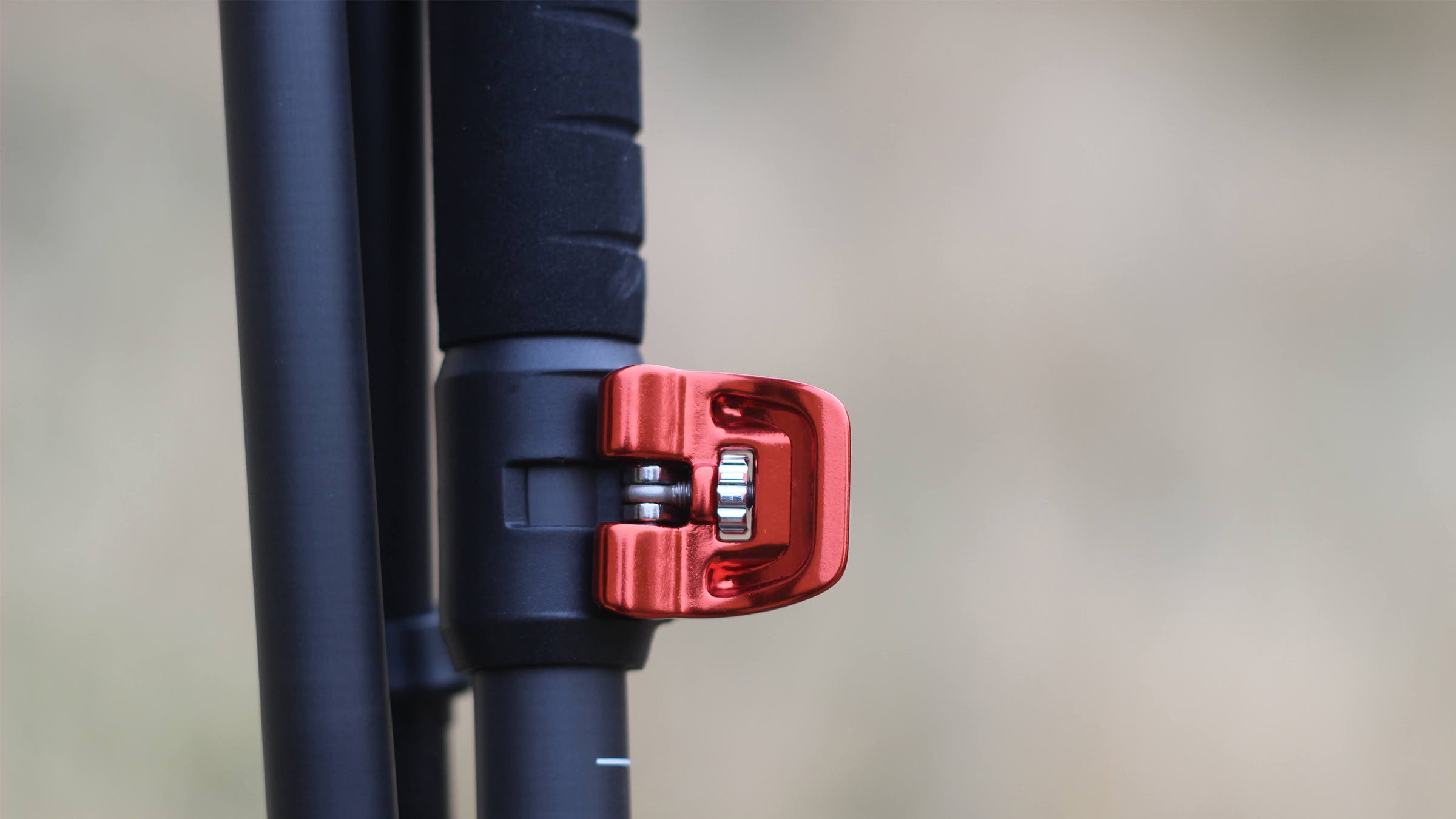
How to Choose Trekking Poles
Pole Length
The most important feature of any trekking pole is length. This is especially important for fixed-length poles, but even with adjustable poles, you want to make sure your preferred length is within the range of adjustment, especially if you are particularly short or tall. Measure your pole length by standing on flat ground with your arms held in front of you, elbows at a 90-degree angle. Your ideal pole length is the distance from your hands to the ground. Adjustable poles give you some wiggle room depending on your hiking style—many people prefer to shorten their poles during sustained climbs and elongate them during descents. If you plan to use your poles to set up your shelter, double check the length required for an optimal pitch. You’ll want to ensure that your poles can adjust to accommodate both your hiking length and your shelter set-up length.
Materials
Pole material is an important consideration as well. Aluminum is generally less expensive and heavier, while carbon is stiffer and lighter. Consider that an aluminum pole will likely bend under strong lateral forces (like getting pinched between rocks) while a carbon pole is more likely to break and become unusable.
Telescoping vs. Folding Poles
Finally, telescopic poles will generally have a larger range of adjustment but a longer packed length, while folding poles will pack down shorter but offer less length adjustment. Some poles offer a fusion of styles.
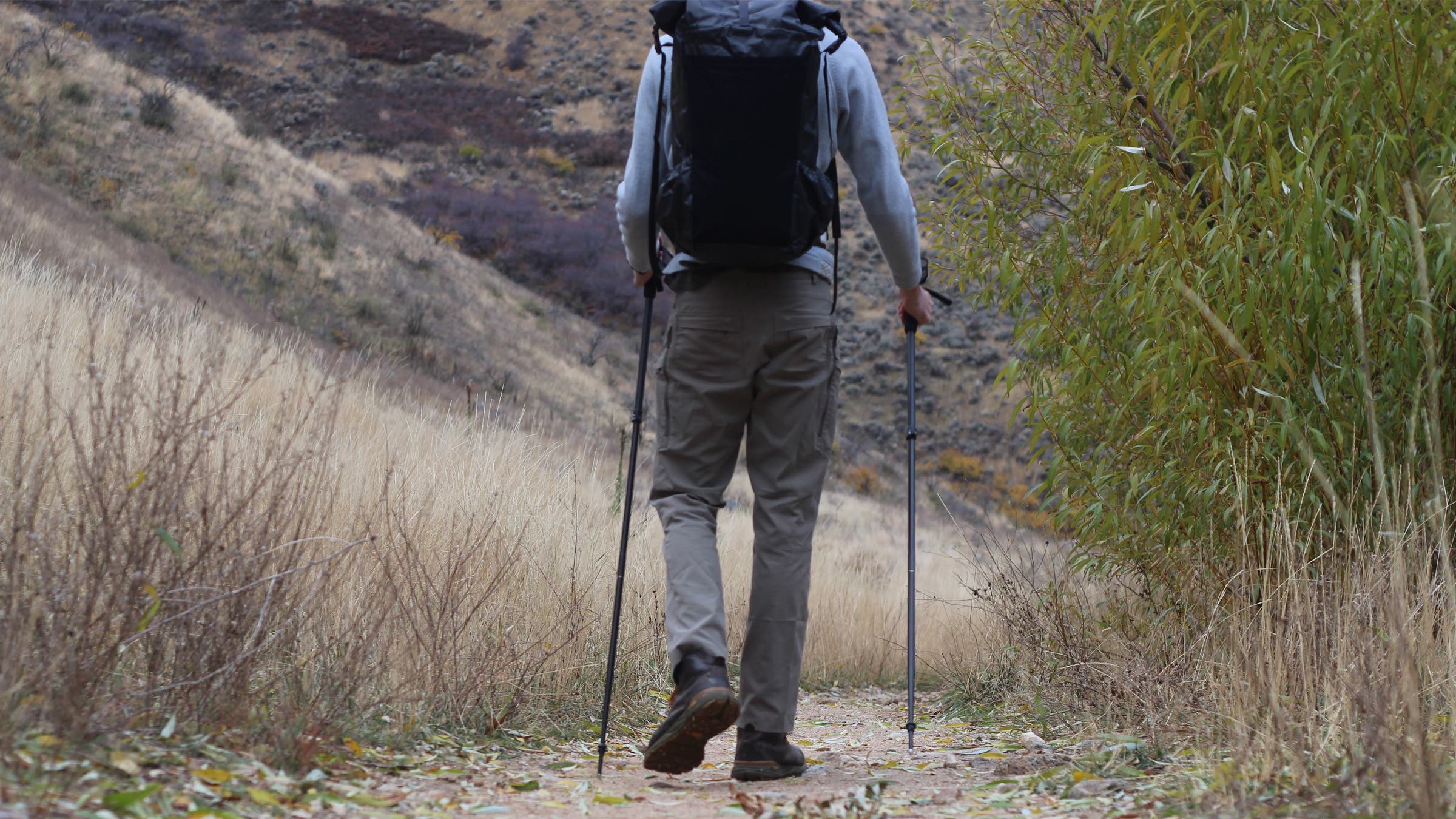
How We Test
- Number of testers: 9
- Number of products tested: 49
- Distance covered: 350+ miles
- Elevation Gained: 45,000+ feet
- Number of tarps/tents erected: 13
- Tallest pyramid tarp erected: 6 feet
Every year, we test the latest trekking poles and stack them up against our tried-and-true picks. We assemble a team of testers who head out on trips ranging from simple day hikes to epic thru-hikes. Our poles are tested in multiple states, regularly including Washington, North Carolina, and California, and often multiple countries—this year’s testing locales included Nepal and Patagonia. Our testers use poles to climb steep trails, set up tarp shelters in sustained winds, and save their ankles on sketchy, rocky descents. Along the way, we task the team with recording every detail, from ergonomics and comfort to ease of use and packability.
Meet Our Testers
Nathan Pipenberg is our category manager for trekking poles, as well as backpacking sleeping bags and sleeping pads. He’s also Backpacker’s ultralight columnist, a thru-hiker, a one-time trail builder and wildland firefighter, and enjoys making his own backpacking gear in his free time. Over the course of his hiking career, he has broken three pairs of ultralight carbon poles, set up a tarp tent using bent ski poles, and hiked 200 miles with a pair of cheap trekking poles bought during a last-minute Walmart stop.